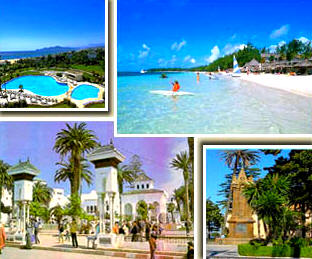 TÉTOUAN TÉTOUAN
In the words of Arab poets, Tetouan is a white dove, “the sister of Fez”, “the little Jerusalem”, or “the daughter of Granada”. The town, built partly on the slopes of Jbel Dersa, was inhabited by Jewish refugees from Granada in the 15th century,
then by moors from Andalusia in the 17th century. The town’s Andalusian heritage can be seen in its medina, as well as its culinary traditions, music and craft of embroidery. In the 18th century the city had acquired such an importance in trade with Europe
that it became Morocco’s diplomatic capital. The Spanish, who held Tetouan from 1860 to 1862, made it their capital during the Protectorate, building a new town on the West side of the old Andalusian medina.
Ville Nouvelle
It is on the Place Moulay El Mehdi – which is sometimes still referred to as by the town’s inhabitants as Place Primo (after the Spanish politician José Primo de Rivera) – that the Spanish colonial architecture of Ville Nouvelle (New Town) is at its most eloquent. With a main post office, bank and church (1926), the square looks like any other central town square in Spain. Both the town’s principal thoroughfare, Boulevard Mohammed V, and the Hassan II square come to life in the evening with the paseo (promenade), a Spanish custom that is more deeply ingrained in Tetouan than elsewhere.
Medina
Tetouan’s medina, now a World Heritage Site, is the most strongly Andalusian of all Moroccan medinas. Emigrants from Spain who arrived in the 15th and 17th century implanted their architectural traditions here. The aroma of spices, freshly sawn wood and bread fills the medina’s narrow streets, squares and souks, which bustle with carpenters, slippers makers, drapers, tanners and sellers
of second-hand goods. Rue El Mokadem is the street most densely packed with shops, but also one of the most noteworthy for its impressive white buildings and its paving. Sellers of Riffian fabrics and pottery fill the small shady square where the El Houts souk takes place, leading to the former Mellah, Tetouan’s Jewish quarter.
Museums
The rooms of the Archaeological Museum contain objects dating from the Roman period that were discovered on a Roman
site on the outskirts of Tetouan. Showing mosaics, pottery, coins and bronzes inside, the museums most interesting
exhibits – such as ancient inscriptions, mosaic floors and Muslim funerary steles with the David star - are laid out in the garden. Occupying a bastion built in 1828, the Moroccan Art Museum is laid out in an Andalusian palace with a garden, a fountain
clad in zellij tilework and red-tiled awnings, typical of Tetouan buildings. The furniture, the craftsman-made pieces, the costumes
and musical instruments illustrate the town’s traditions. The Craft School near the museum occupies a residence built in 1928
in Moorish style. Specializing in local traditions, the leatherwork, pottery, mosaic, carpets and decorative plasterworks
of the students is displayed in a domed exhibition hall.
Weather
Winter temperature = 10 - 20°C. Summer = 20 – 30°C.
Mediterranean climate with rainy winters and high humidity level throughout the year. |